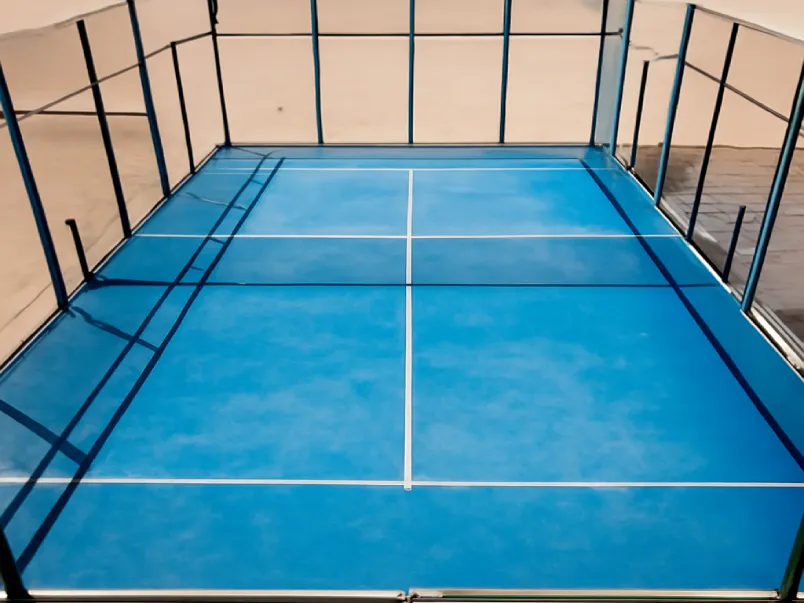Padel is a sport that has been taking the world by storm, captivating players with its fast pace and strategic depth. With its unique blend of tennis and squash, padel is defined by the distinctive design of its court. If you’re new to the game or looking to deepen your understanding, learning the official padel court dimensions is a critical step to mastering the sport. In this comprehensive guide, we’ll break down each measurement of the court and explain how these dimensions shape gameplay, strategy, and safety.
More Than Just a Box
Imagine you’re in a tense match, racing to intercept a high-speed smash that somehow stays in play thanks to the glass. Or picture yourself executing the perfect “bandeja” – a strategic shot that uses the full length of the court. The design of the padel court plays a crucial role in such moments, impacting both the flow of the game and the strategies players employ.
Padel’s rapid growth around the world is driven by its ability to appeal to players of all ages and skill levels. But while the sport itself may seem simple on the surface, the court’s dimensions are far from arbitrary. Every inch is meticulously calculated to create the perfect balance of offense, defense, and strategy. Understanding these measurements will not only help you improve your gameplay but also give you a deeper appreciation for the sport itself.
I. The Blueprint: Official Padel Court Dimensions
To truly grasp the intricacies of padel, let’s first dive into the core dimensions of the official padel court.
A. Overall Court Size (The “Box”)
The padel court has specific measurements that distinguish it from other racket sports:
- Length: 20 meters
- Width: 10 meters
These dimensions create a rectangular playing area that is quite different from the larger court of tennis or the smaller size of a pickleball court. The length and width of the court significantly influence the dynamics of the game, dictating movement patterns, shot selection, and overall strategy.
Visual: The court is divided in the middle by a net, which separates the two sides of play. The dimensions are fixed and standardized, ensuring consistency across all professional matches.
B. The Net
The net sits in the center of the court, dividing it into two halves. Unlike tennis, the net in padel has unique height specifications:
- Height at the center: 0.88 meters
- Height at the posts: 0.92 meters
The difference in height between the center and posts allows the net to sag slightly, creating a consistent playing plane. This subtle feature helps maintain a balanced and fair game, where the height of the net does not give any one player an unfair advantage.
C. The Service Lines
When it comes to serving, padel has very distinct rules about where the server must stand and where the ball must land. These areas are marked by a few key lines:
- Service Line: This line is located 3 meters from the back wall.
- Central Service Line: Divides the two service boxes down the middle.
- Service Boxes: The two rectangles on either side of the central service line measure 5 meters by 3 meters.
These lines ensure that the serve is executed under specific conditions, emphasizing control and placement over power, and also influencing the strategy of each point.
D. The Walls (The “Cage”)
The use of walls is one of the most distinctive features of padel. The court is surrounded by walls that create an enclosed space, known as the “cage.”
- Back and Side Walls: The minimum height of the back and side walls is 3 meters, with most courts utilizing transparent glass or acrylic materials.
- “Metallic Door” (Entrance): The non-glass entrance areas must also be 3 meters high, ensuring safety while allowing easy access to the court.
The walls play a huge role in the game’s strategy. They allow players to use them for defensive shots and keep the ball in play in ways that are impossible in other sports. This unique feature requires players to develop skills that are specific to padel.
E. The “Bajada de la Pared” (The Wire Mesh Zone)
Above the glass walls, there’s a crucial area filled with wire mesh, commonly referred to as the “Bajada de la Pared.”
- Height: The wire mesh zone spans from the top of the glass wall (3 meters) to the full height of the court (4 meters).
- Strategic Impact: Balls that hit the mesh will bounce differently compared to those that hit the glass. This requires players to learn how to anticipate these varied bounces and use them to their advantage.
This metal mesh zone is an integral part of advanced play, offering opportunities for strategic ball control that can alter the course of a game.
II. Why It All Matters: The Impact on Gameplay and Strategy
Now that we’ve covered the key measurements, let’s explore how these dimensions translate into real-world gameplay and strategy.
A. The 20m Length: The Art of Depth and Patience
The 20-meter length of the court plays a pivotal role in shaping the dynamics of the game. Unlike tennis, where rallies tend to stay close to the baseline, padel forces players to move up and back along the court, engaging in the “up-and-back” dynamic.
- Encourages Lobs: With such a long court, players often use lobs (“globos”) to push opponents back, creating space and altering the rhythm of the rally.
- Drop Shots and Vibora Shots: The mid-court area, often where players stand to strike drop shots or “vibora” (a slicing shot), becomes a critical zone where strategic shot placement is essential.
The length of the court encourages patience and precise positioning, making every rally an opportunity to control the pace of the game.
B. The 10m Width: Teamwork and Angles
While the 20-meter length demands patience, the 10-meter width places an emphasis on teamwork and communication, especially in doubles play.
- Strategic Placement: The narrow width makes it harder to hit outright winners, meaning that sharp angles and smart shot placement become essential.
- Side Walls: Using the side walls creatively adds another dimension to the game. Players often use them to produce angled shots that are difficult to return, making teamwork and anticipation key to success.
Players must communicate effectively with their partner to cover the entire width of the court and use angles to their advantage.
C. The 3m Service Line: The Neutralizing Serve
The 3-meter service line forces players to rethink the traditional serve. Unlike tennis, where a powerful serve can end the point immediately, padel’s service lines neutralize any attempt at overpowering serves.
- Serve Focus: The server must focus on placement, spin, and variety rather than trying to win the point outright.
- Serve-and-Volley: The shorter court length encourages players to move quickly to the net after serving, making the serve-and-volley tactic a common strategy.
The service lines create a more balanced game, where skillful serving and returning are paramount.
D. The Walls: The “X-Factor”
The walls are where padel really sets itself apart from other racket sports. They serve as both a defensive tool and a way to create unique offensive shots.
- Defensive Shots: Players can use the walls to return difficult balls, keeping the rally alive and leveling the playing field for less powerful players.
- Off-the-Wall Shots: The ability to anticipate how the ball will bounce off the walls is a skill that advanced players master. Understanding the difference in bounce between the mesh and glass adds another layer of complexity to the game.
The walls offer a strategic advantage that forces players to adapt and think creatively, making them a defining feature of padel.
E. The Net Height: The Battle at the Net
The low net height of 0.88 meters (at the center) in padel makes volleys and overhead smashes the primary way to end points.
- Volleys and Smashes: Players who can dominate the net will have a significant advantage, as controlling the net position is crucial to maintaining offensive pressure.
- Rallying at the Net: Players must react quickly and place their shots precisely to avoid getting caught at the net by their opponent’s counterattacks.
The net height encourages a fast-paced game that rewards agility, anticipation, and control of the net.
III. Padel vs. Pickleball vs. Tennis: A Court Dimension Comparison
For those familiar with other racket sports, it’s helpful to see how padel’s court compares to tennis and pickleball. Here’s a quick comparison of the key dimensions:
| Aspect | Padel | Tennis | Pickleball |
|---|---|---|---|
| Court Size | 20m x 10m | 23.77m x 8.23m | 13.41m x 6.10m |
| Net Height | 0.88m (center) | 0.914m (center) | 0.86m (center) |
| Key Differentiator | Use of walls | No walls | No walls |
While tennis and pickleball share similar court dimensions, the use of walls in padel creates a distinct strategic element that sets it apart.
IV. Common Mistakes and Misconceptions
Even experienced players can sometimes fall into common traps when it comes to padel strategy. Here are a few things to watch out for:
- Mistake 1: Trying to play with tennis-like power and flat shots. The walls are an essential part of padel, and ignoring them can limit your potential for creative shots.
- Mistake 2: Underestimating the importance of the lob. With such a long court, the lob is a critical tool for pushing opponents back and controlling the rally.
- Misconception: Many players mistakenly think that because the court is smaller than a tennis court, the game is easier. In reality, padel is a complex game that demands strategic thinking, skillful shot placement, and precise movement.
Conclusion: Mastering the Space
In conclusion, padel is a game of geometry and strategy defined by its unique court dimensions. Every aspect of the court, from the length and width to the net height and the walls, plays a vital role in shaping gameplay. Understanding these dimensions is essential for mastering the sport and becoming a better player. The next time you step onto the court, remember that you’re not just looking at lines and walls; you’re facing a battlefield full of strategic possibilities. And that’s the first step to winning the game.
FAQs
1. What are the official dimensions of a padel court?
A standard padel court is 20 meters long and 10 meters wide. The net is 0.88 meters high at the center and 0.92 meters at the posts.
2. How do the walls affect padel gameplay?
The walls play a critical role in padel, allowing players to use them for defense and creating unique offensive shots. Balls that bounce off the walls behave differently than those that hit the glass, offering strategic opportunities.
3. Can I play singles on a padel court?
Yes, you can play singles, but it’s less common. When playing singles, the court is typically slightly narrower than the standard doubles court, making the game more challenging.
4. Why is the service line 3 meters from the back wall?
The 3-meter service line prevents overpowering serves like in tennis, forcing players to focus on placement and spin rather than power. This encourages more strategic serves and a more balanced game.
5. What is the “Bajada de la Pared” in padel?
The “Bajada de la Pared” refers to the area between the top of the glass wall (3 meters high) and the full height of the court (4 meters), filled with wire mesh. Balls that hit the mesh bounce differently, adding complexity to the game.
6. What makes padel different from tennis and pickleball?
Padel features the use of walls, which is not seen in either tennis or pickleball. This allows for unique shots and adds a strategic element not found in the other sports.




